
Medal (dated 1611, by F. A. Casoni) depicting two sides of the Bolognese painter Lavinia Fontana. The reverse legend: PER TE STATO GIOIOSO MI MANTENE (“because of you I am in a constant fervor”). Credit: Dr Busso Peus Nachfolger
Well, this certainly is unexpected. Just announced in Sweden by the renowned Uppsala Auktionskammare is the rediscovery of a brilliant example of Boncompagni patronage of the arts. It is a 1594 portrait by none other than Lavinia Fontana (1552-1614).
Fontana’s subject? Costanza Sforza of Santa Fiore (1560-1617), wife of the Duke of Sora, Giacomo Boncompagni (1548-1612). Giacomo himself was the legitimated son of Ugo Boncompagni = Pope Gregory XIII (1505-1572-1585). So at the time of her marriage in 1576—at the Apostolic Palace in the Vatican, with the whole College of Cardinals in attendance—Costanza Sforza found herself in the unusual position of daughter-in-law to a reigning Pope.

The rediscovered portrait of Costanza Sforza by Bolognese painter Lavinia Fontana. The sale by Uppsala Auktionskammare takes place 14 June 2016. Credit: Uppsala Auktionskammare
There is a lot to say about Costanza Sforza, but we’ll be brief, at least here. She was the daughter of the condottiero Sforza Sforza, Count of Santa Fiora, near Parma. Yet her focus necessarily shifted south of Rome on becoming Duchess of Sora (southeastern Lazio) when she married Giacomo Boncompagni in 1576—and especially after 1585, with the death of Giacomo’s father Gregory XIII. The couple made Isola del Liri (8km SW of Sora) their principal home, yet also maintained a magnificent castle north of Bologna at Vignola.
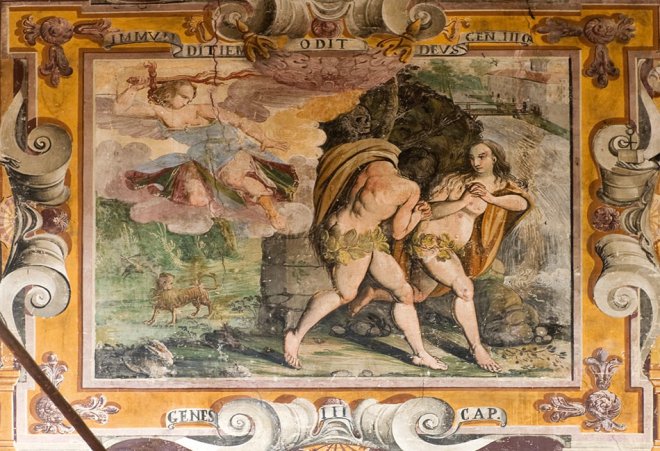
Allegorical scene (ca. 1588) of the expulsion from Eden, from the Salone of the Castello Boncompagni-Viscogliosi, Isola del Liri. The vengeful angel represents Pope Sixtus V and the couple—clearly pictured in flight to Isola del Liri—none other than Giacomo Boncompagni and Costanza Sforza, vulnerable after the death of Giacomo’s father Gregory XIII
Lavinia Fontana formed an extraordinarily close relationship with Costanza Sforza. The biographer of the great Bolognese painters, Carlo Cesare Malvasia, alleges that Fontana frequently visited the Boncompagni at both Isola del Liri and Vignola. Perhaps it was at Vignola that she painted twin portraits of the couple that have long been known (see below), one of which she dated explicitly to 1594. In 1595 Fontana saw Sforza become the godmother of her last child—whom she named Costanza.
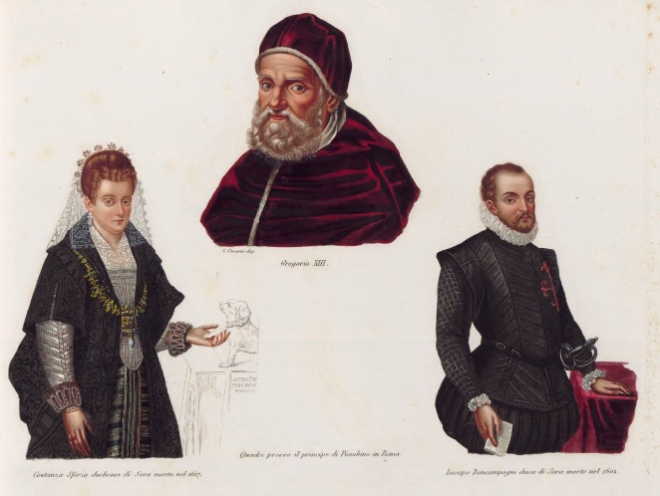
From Pompeo Litta, Famiglie celebri italiane II (1836). The images of Costanza Sforza and Giacomo Boncompagni reproduce their (1594) portraits by Lavinia Fontana
Giacomo Boncompagni died in 1612, but his widow continued to exercise conspicuous patronage. In 1614, with the blessing of Pope Paul V Borghese, she invited the Jesuits to set up a college at Sora (now the site of the town hall), and attached a new church to it, Santo Spirito. Costanza Sforza died on 22 January 1617, survived by seven of her 14 children. Through her son Gregorio I Boncompagni (1590-1628), she is the direct ancestress of all subsequent heads of the Boncompagni (later Boncompagni Ludovisi) family.
The origins of the Uppsala portrait of Costanza Sforza should date to a flying visit the Duke and Duchess made to Bologna on 11 June 1593, sumptuously described by Caroline P. Murphy (from unpublished Bolognese chroniclers) in her 2003 book Lavinia Fontana: A Painter and her Patrons in Sixteenth-Century Bologna.
In the painting, Costanza stands (as Uppsala Auktionskammare tells us) “three quarter length by a colonnade, her right hand resting on the armrest of a chair, with a prayer book in her left hand, dressed in a richly ornated dress with lace collar and ermine lined cape, a gold chain on her neck and pearls in her hair. Signed with monogram LDF and dated 1594. Oil on relined canvas, 112 x 88 cm.”
We should stop typing and let Uppsala Auktionskammare, which made the exciting rediscovery, describe the painting further.
“This hitherto unknown portrait, which has recently appeared from the private collection of descendants of Wilhelm Tschögel in Sweden, is an important discovery. The refined painterly quality, its excellent state of conservation and the importance of the sitter suggest that this portrait must have been among Lavinia’s most important portrait commissions.”
“The portrait is thus an important addition to the oeuvre by the artist, as compiled by Maria Teresa Cantaro, Lavinia Fontana Bolognese: “Pittora Singolare” 1552 – 1614, 1989 and stylistically connects with the Portrait of Ginevra Aldrovandi Ercolani, of circa 1595, in the Walters Art Gallery, Baltimore (Cantaro no. 4A 80) and the Portrait of Costanza Alidori, of which the present location is unknown.”

Lavinia Fontana’s Portrait of Ginevra Aldovrandi Ercolani, from the Walters Art Museum, Baltimore
“In the fine portrait of Costanza Sforza Boncompagni her position as a duchess from southern Italy, being the Duchess of Sora, is demonstrated through her meticulously rendered dress. As such it has numerous features not seen in northern Italian costume – for instance her bodice tapers into a narrow point and is embroidered with a pattern not seen in the portraits of Bolognese noblewomen. Furthermore the fine details of the dress and the jewels as well as the ermine lined cape underline her wealth, richness and importance.”
“Dr Francesco Petrucci…has fully confirmed the painting’s authenticity on the basis of a high-resolution image. He has pointed out that the signature L D F is that which was frequently used by the artist after her marriage with Paolo Zappi in 1577….As pointed out by Dr Petrucci, the identification of the sitter is suggested by the date of execution of the portrait in 1594.”
“As confirmed by Carlo Cesare Malvasia, who wrote the first biographies of Bolognese masters, Lavinia’s contacts with the Boncompagni family were particularly close in those years, following the five-day visit of the couple to the city in June 1593. Upon their arrival Lavinia, already well established as the portraitist of the Bolognese class of noblewomen, was driven to the Boncompagni family palace, no doubt awaiting portrait commissions.”
“One of these commissions must have been the pair, of which that of Giacomo Boncompagni is now lost and is only known through an engraving (see Cantaro no. 4A 72) [but see image below—Ed.] and the heavily damaged portrait of Costanza, in the Casino del Aurora dei Principi Boncompagni Ludovisi, Sala della Fama (Cantaro no. 4A 73).”
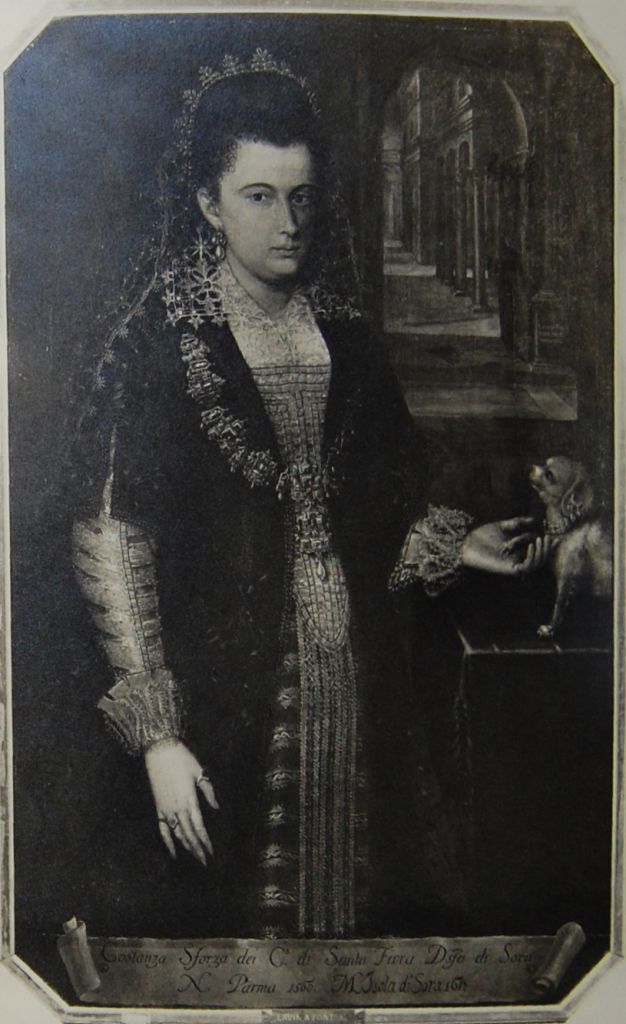
Above: paired portraits of Giacomo Boncompagni (wearing the cross of the Order of Calatrava, which he received from Philip II of Spain in 1582) and Costanza Sforza, the latter dated to 1594 and signed by Lavinia Fontana. The identifying tituli are later (?18th c.) additions; the unusual octagon frames shows that they were once on display at the Boncompagni Ludovisi’s late 19th century Palazzo Piombino on the Via Veneto, Rome. Note the dog’s earring; canine jewelry was a fashion attribute of Bologna in this period. The images are found in an unpublished 1940/1 MS by Boncompagni Ludovisi archivist and historian Giuseppe Felici. Collection of HSH Prince Nicolò and HSH Princess Rita Boncompagni Ludovisi, Rome.
Uppsala Auktionskammare continues, “Lavinia Fontana takes an important place in the history of art, as the first female artist to set out a well planned strategy for her artistic career….Lavinia Fontana’s portraiture became a hype among the Pepoli, Bargellini, Malvezzi, Ruini and other families and culminated when Costanza Sforza came to the city, as the wife of the illegimate son of Pope Gregory XIII, himself a Boncompagni.”
The provenance? “According to family legend a gift of Count Cavriani of Mantua to Wilhelm Tschögel (1851–1926), Vienna. Thence by descent to the present owner.”
More to discuss, but we’ll leave the excitement at that for now!

Fabritio Caroso’s 1600 treatise on dance, La nobilità di dame, with the opening for the choreography for ‘Amor costante’, dedicated to Costanza Sforza, followed by Caroso’s lute tablature for the piece. On this fascinating work, see now Rebecca Cypess, Curious and Modern Inventions: Instrumental Music as Discovery in Galileo’s Italy (2015).
Special thanks indeed to Julia Unge Sörling (Uppsala Auktionskammare) for alerting us to this important sale
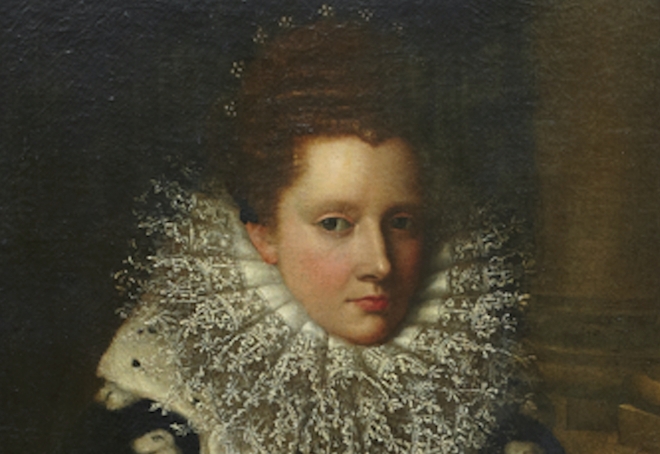

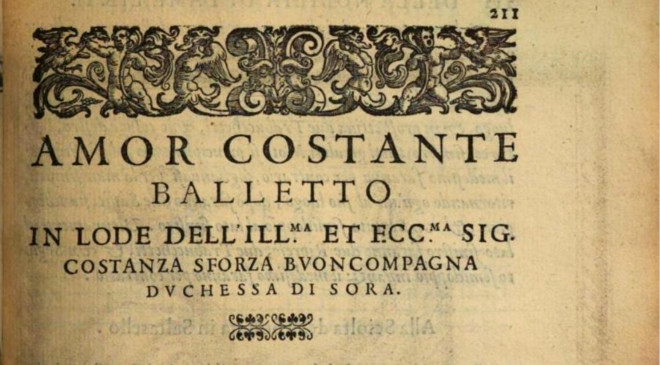
[…] rediscovery of a portrait by Lavinia Fontana (1552-1614) was announced this week. As announced on the Villa Ludovisi website the subject shows “Costanza Sforza of Santa Fiore […]